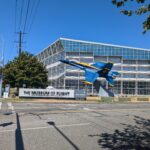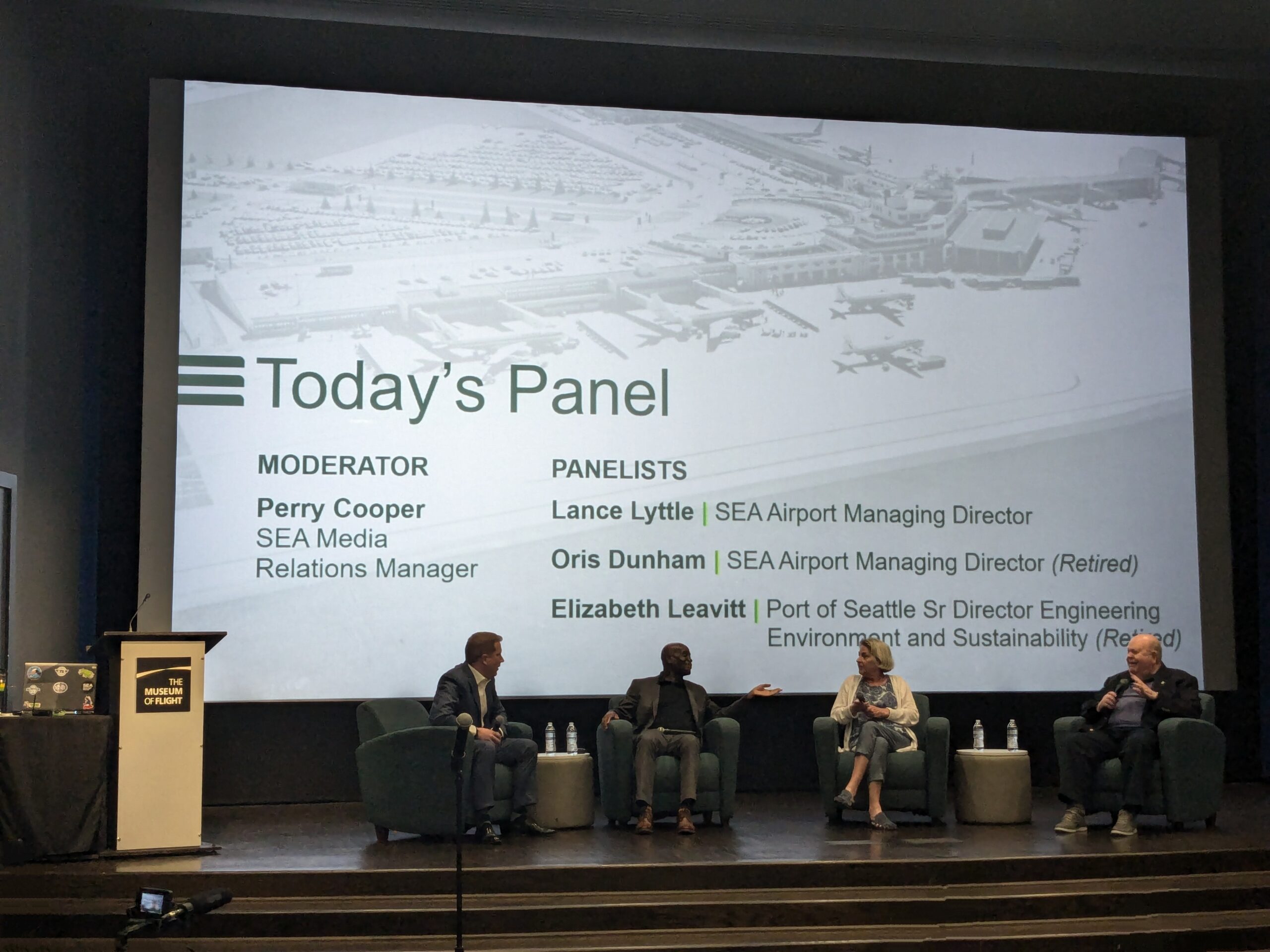You can handle 100,000,000 passengers a year…
 Today, at the Boeing Museum Of Flight, the Port of Seattle premiered the first in a series of videos charting the history and growth of Sea-Tac Airport.
Today, at the Boeing Museum Of Flight, the Port of Seattle premiered the first in a series of videos charting the history and growth of Sea-Tac Airport.
The videos, collectively titled Elevated, were introduced by Port CEO Stephen Metruck, who spoke about the challenges of continuing to serve the needs of passengers and regional economic growth. A thirty minute compilation clip was shown culled from the entire movie series.
The video was followed by a panel discussion, moderated by Rising Tides and Tail Winds author Casey McNerthney, featured a wide-ranging set of reminiscences from current Airport Director Lance Lyttle, Third Runway Environmental Manager Elizabeth Leavitt and 80’s Airport Director Oris Dunham.
The panel then took an hour’s worth of audience questions, most of which were from aviation enthusiasts and quite detailed
(Example: Can we have an observation deck like Tokyo Airport? Answer from Director Lyttle: Unfortunately, we do not have enough land to accommodate that given the need to maximize space for improving passenger flows.)

What we found interesting
Personal stories
Each of the three former leaders gave a short bio and discussed how they came to their roles at Sea-Tac Airport. Interestingly, none of the three came to their roles as subject matter experts. For example, Leavitt, responsible for permitting during the controversial Third Runway, had no experience in environmental management.
Wildlife
The movie clips shown opened with a lengthy segment on wildlife. In 1976, following the Sea-Tac Communities Plan, the airport hired its first biologist to try to keep birds at bay, ‘bird strike’ having caused a significant commercial aviation accidents. That effort has increased dramatically over the years and now the airport keeps four biologists on staff and manages birds up to five miles away from the runway.
The airport does its best to promote this as being environmentally responsible. But it’s just a fact that moving so much wildlife and tree canopy outside the runways has a significant impact on the ecosystem of surrounding communities far beyond airport property.
Third Runway
Leavitt talked about the personal stress of constant delays in obtaining permits to build the Third Runway.
StART
Lyttle commented on what he considers to be the great success of the Sea-Tac Airport Roundtable (StART). He said that the community group was in danger of ending in 2020 when half the member cities (Burien, Des Moines, Federal Way) quit. He talked about how much work was involved in keeping it running until those three cities rejoined, not mentioning that none of the demands of the three cities had been addressed.
A construction company with an airport on the side
Dunham talked about the construction during his tenure in the 1980’s. This is the situation the airport currently finds itself in with the Sustainable Airport Master Plan (SAMP). Construction projects which are increasing airport operations are occurring now.
Lyttle referred to Sea-Tac Airport as ‘a construction company with an airport on the side’. Many people do not realize how much of the local construction industry depends on the Port for its survival. This further incentivizes local governments, unions and businesses to constantly expand operations.
Dunham and Lyttle engaged in some good-natured banter over the need to rebuild so many of the facilities after only 30 years. Dunham remarked that when they were building, they had no idea operations would ever exceed 30 million passengers per year. In 2019, the airport processed 51 million.
Marketing
Other participants applauded Director Lyttle’s successes in bringing more routes to the airport. Lyttle himself was very open about his desire to obtain more routes and airlines as they can be made profitable.
Paine Field
All agreed that Paine field is not a realistic solution for reducing the demand at Sea-Tac Airport. To give some context, Paine Field’s maximum expansion plans call for adding, at most, only 3-4 gates and perhaps 200 flights a day. Contrast that with SEA which now often processes 1,200.
Second Campus
Interestingly, the preferred term of art for a second regional airport now seems to be ‘second campus’. We’re not sure of the significance but usually a ‘campus’ is defined as an outpost for a singular organization.
Expansion
Lyttle continued to repeat the Port’s current line: The SAMP Near Term Projects (2028) will get the airport to 56 million passengers per year. The Long Term Projects (2032?) will increase that to 66 million. They do not believe they can accommodate more passengers beyond that without increasing wait times to an unacceptable level.
When asked by an audience member, “Do you ever see a time when the airport will voluntarily stop trying to expand due to capacity limits?” Director Lyttle deflected, saying “You could handle 100,000,000 passengers a year. The only question is, how long do you want them to wait?”
Interestingly, however, there was no mention of any such limits on cargo–which is increasingly scheduled for off-peak hours to accommodate customers in Asia.
What we think
When Lance Lyttle was hired as airport director eight years ago, the SAMP process was in its infancy. The Port’s line then was that the airport was only responding to airline demand. That was never true. The airport was always marketing for growth, which is how it became the hub for Delta and Alaska Air in 2012 which started its double-digit annual growth.
With the benefit of hindsight, we can now see the Third Runway, not for what the community thought it would be (to safely land flights in inclement weather… etc.) but for what it is: the enabler of a long-term strategy to change Sea-Tac Airport from a somewhat regional facility into the strategic hub for the entire Pacific Northwest. Looking south at Portland, a much larger facility–and far more capable of handling more traffic into the future, we now see this clearly: King County wanted the growth.
When Lyttle chides Dunham about how much of the facilities need to be rebuilt (implying that they weren’t built to last), it’s not a joke. Dunham correctly points out that they assumed that, after about 30 million passengers a year the airport would be at capacity. It would be full.
The assumption back in the 1980’s was that there would be a hard, technological limit to signal the absolute need to build another airport; not to continue to expand Sea-Tac.
Before Dunham, the Second Runway (the center runway 16C) was built ‘too close’ to the east runway due to constraints on available land. At the time it was considered a blunder which would limit the usefulness of having two runways, because it made it impossible to accommodate parallel landings using conventional RADAR. And yet, in 2000, years before the Third Runway, Sea-Tac processed over 400,000 flights a year–as many operations as it did in 2017!
Every time there has been a so-called ‘limit’, technology finds a way and re-defines what is considered possible and practical.
Remember Director Lyttle’s answer when asked if there is an upper limit to Sea-Tac’s capacity:
You could handle 100,000,000 passengers a year. The question is, how long do you want them to wait?
From a certain point of view that was the honest answer. There is no upper limit to the number of operations the airport can handle. It just depends on how long people want to wait. It also means that the airport itself will never say ‘enough’.
And the community has ignored these two facts:
- Every time airport planners have said, “There’s no way we can handle more…” technology finds a way. It is simply disingenuous to argue otherwise based on so much historical precedence.
- Without a hard limit, and with the Port of Seattle aggressively promoting more routes (both passenger and cargo) there will never be a second campus. Why should there be, when all the stakeholders (airlines, shippers, logistics) are settled here. It is only when there is a sign that says ‘full up’ that people look for another place to go.
As we’ve said many times, the FAA controls most things at large airports like SEA. However, the one bit of local control every operator can assert is that ‘full up’ sign. Any day of the week, the Port of Seattle can write a letter to the FAA saying they have reached capacity. That does not mean the FAA will comply.
Despite several turning points in this history of Sea-Tac Airport, where even airport directors felt there was no place left to build, no one, at the Port, or local, State or Federal levels of government, has even considered saying, in a real way, ‘enough’.

Thanks for reporting on this – I had considered going, but after testifying earlier in the week before the Port Commission could not make room in my schedule for another appearance.
Our citizen-based group, Defenders of Highline Forest, has been saying “enough.” Maybe instead we need to be asserting “too much already.”
Thank you. The effect the airport has on the surrounding ecosystem should not be underestimated. By controlling the flora and fauna on the AAA, as well as other property, the Port’s four biologists, and other staff have a great influence on plant, wildlife and water for many miles beyond their fence line. And yet, they are not required to mitigate against any of those secondary impacts. In the movie, they acknowledge that during the early years of the airport, they would encounter flocks of ‘over a hundred thousand birds’.